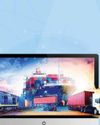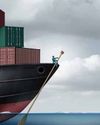
Setting the tone for the third session Ravi Ramprasad, Editor-in-Chief, Maritime Gateway shared results of a survey which revealed there is about 44 per cent technology adoption in organizations, still 39 per cent of the enterprises are moderate, 14 per cent poor, and 3 per cent still to use technology. Top three challenges faced by ports where technology can help include paper work, delays in container identification and clearances, and lack of coordination among stakeholders. Challenges in technology adaption include non-supportive stakeholders who are using different platforms resulting in no data exchange or are stuck with paper documentation. A staggering 45 per cent of the gate entry/exit systems at ports are still manual.
Integration challenges also exist wherein companies have invested in traditional software platforms and when the changeover happens it is difficult to integrate. To track port and terminal efficiency about 16 per cent use excel sheets, 16 per cent use manual reporting, and Web application is used by 25 per cent. About 57 per cent of ports and terminals have not migrated to PCS.
Factors that impact port congestion include inadequate infrastructure, poor coordination of traffic, and congested roads. Use of paper documentation: Gate entry/exit (88 per cent); Truck movement (81 per cent); Customs interaction (82 per cent) and Shipper data exchange (82 per cent).
Exchange of shipping bills, bills of lading, and bills of entry documents between different entities: paper documents (44 per cent); online (41 per cent).
Ramprasad, Editor-in-Chief, Maritime Gateway: What is the value addition you are bringing to PCS and how it can help the customers?
Liji Nowal, MD, ODex India Solutions Pvt Ltd: We along with other platform service providers are struggling with this question of how do we add value to the community?
Denne historien er fra October 2019-utgaven av Maritime Gateway.
Start din 7-dagers gratis prøveperiode på Magzter GOLD for å få tilgang til tusenvis av utvalgte premiumhistorier og 9000+ magasiner og aviser.
Allerede abonnent ? Logg på
Denne historien er fra October 2019-utgaven av Maritime Gateway.
Start din 7-dagers gratis prøveperiode på Magzter GOLD for å få tilgang til tusenvis av utvalgte premiumhistorier og 9000+ magasiner og aviser.
Allerede abonnent? Logg på

Impact Of Covid-19 On Shipping And Logistics
Industry stalwarts discuss threadbare the prevailing logistics and supply chain scenario and issues in clearing cargo during the COVID-19 lockdown

Digital Platforms Defy Lockdown
Digital trading modules such as eNAM are enabling farmers to move their produce from farm to market even during the lockdown

GARMENT TRADE TRAMPLED
As retailers face a shutdown in US and Europe, the cascading affect has caused mass cancellation of orders in Bangladesh

TRADE RESUMES WITH CHINA
While India has allowed uninterrupted movement of imports into Nepal even during lockdown, China is reopening its borders as it emerges from the pandemic
LESS HUMAN INTENSIVE, MORE DATA DRIVEN
AI provides transformational opportunity for logistics industry by improving customer experience, operational efficiency, faster turnaround time and lower cost while ensuring security and transparency. Macro environment requires industry to transform to be less human intensive, agile and data driven, all of which can be accelerated by AI adoption, shares Gangadhar Gude, Founder & CEO, atai.ai

SHAKEN AND STIRRED
The COVID-19 pandemic has partially paralysed the logistics and supply chain, but the industry is still deterred to ensure supply of essentials continues

TRADE STUCK, ECONOMY SLOWS DOWN
Sri Lankan economy slows down as trade deficit widens and supply chain disrupts amidst lockdown

LENDING INTELLIGENCE TO SUPPLY CHAIN
If you’re shipping millions of dollars’ worth of pharmaceuticals, high-end electronics, expensive seafood, or precious metals, what would you be willing to pay for the ability to ‘ask’ your shipment where it is right now and whether it’s ok? What would you pay for a freight smart enough to raise an alarm before it spoils? Artificial Intelligence enables that and much more…

CONTAINER LINES SIGNAL ‘SOS'
As the per-unit cost of operations increases many lines are forced to blank sailings which has hit their bottom line real hard. The Government and Terminal Operators therefore need to actively consider reduction in Vessel Related Costs

IMO 2020 And The Covid-19 Curse
The COVID-19 outbreak has shaken and stirred the already volatile bunker market. While the refiners adjust their capacities and shipping lines choose their path to compliance, the market dynamics are yet to reach an equilibrium